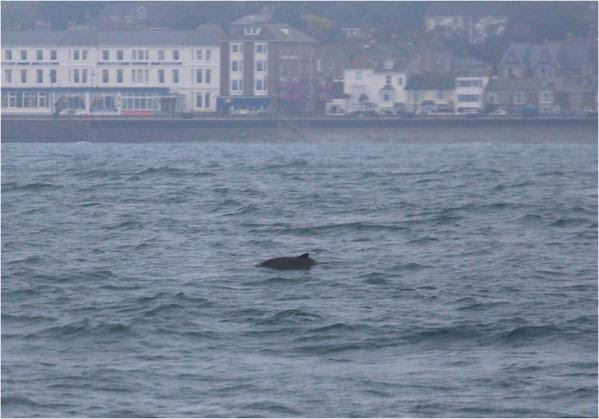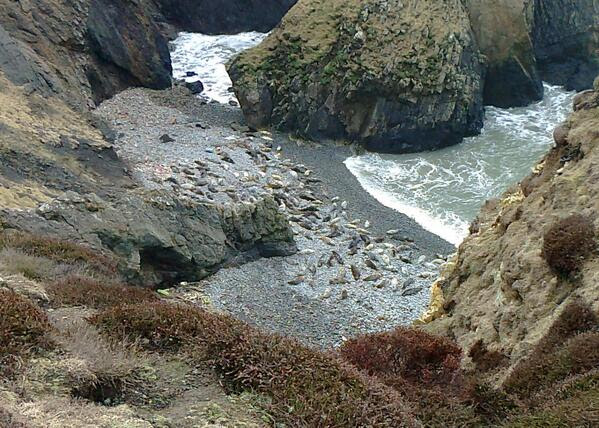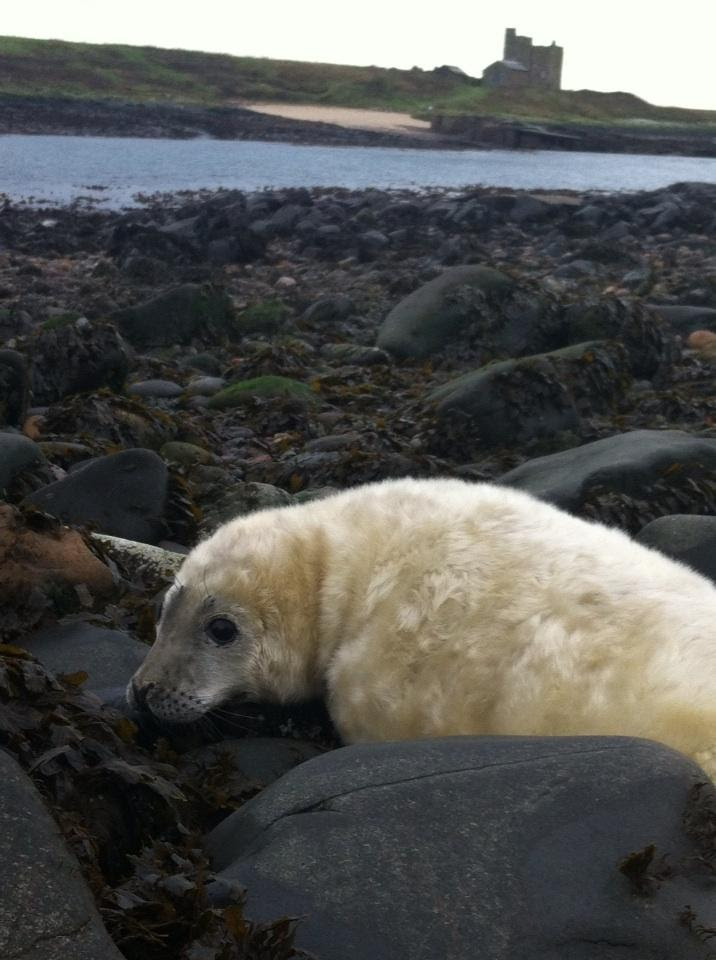
My encounter with a huge #GreySeal, Germany's largest predator, at #Heligoland beach last weekend. #KarlTheKiller?: image via Stephan Lutter @Ocean_Whisperer, 15 September 2014 Börnsen, Herzogtum Lauenberg
Yes, I confess that for some years past
I lacked the zest needed just to live,
except that on my ramblings in the backstreets
I never let myself collapse, but rather
from fields of feeling that were colorless
I swung myself up into the rosy ones, of course
that sounds a bit romantic. Truth to tell,
I became bloated with my zest, knowingly,
and trotted along to find in it myself
when really it was not there, and only
self-enchantment made me young. I never ceased
instructing life to be a help to me,
and all the time it was my projection,
as in a mirror, of any amount of things,
and if there's valor in behaving so
I simply do not know, for all that I tried
not to go down too soon into dejection.
Robert Walser (1878-1956): Yes, I confess that for some years past (Autumn 1928) from Thirty Poems, selected and translated by Christopher Middleton, 2012

A grey seal pup lies
in the grass at the Lincolnshire Wildlife Trust’s Donna Nook nature
reserve in Grimsby, England, where over 800 pups have been born this
year so far. Grey seals have been identified as the mystery killers of harbour porposes: photo by Dan Kitwood via the Guardian, 28 November 2014

Good to see #greyseal 'Bagshot' back on Ramsey today. An ex-rescue from the @Seal_Sanctuary, Cornwall. Nearly 5 now: image via Steph @stephbarnicoat, 22 September 2014

Pups still being born into November. This cow chose the right time - after the storm! #greyseal: image via RSPB Ramsey Island @RSPBRamsey, 4 November 2013
600 and counting....the number of #greyseal pups born on Ramsey so far this autumn #pembrokeshire: image via RSPB Ramsey Island @RSPBRamsey, 7 November 2013
Today's #greyseal haul out had risen to 212 on Porth Lleuog. No sign of the Glaucous gull though: image via RSPB Ramsey Island @RSPBRamsey, 5 March 2014
"@Gladtidings6: A lot of #GreySeal around #farne islands today, the perfect tide conditions to see them, around 4000 here": image via CathyCrowther #@CatbytheC, 30 July 2014
Pretending to be shy #GreySeal pup on the #FarneIslands: image via Laura Shearer @LimpetLaura, 24 November 2014

Seals have been identified as the killers behind the mystery of dead porpoises found with distinct mutilations on Dutch beaches over the past decade. The cause of large numbers of harbour porpoises washing up on the Netherlands coast was previously unknown and contested, but an eight year-long study concludes that grey seals have “learned a new trick” and are preying on them. The author of the paper, published in the journal Proceedings of the Royal Society B, said that there was no reason to think they would not attack humans as well: photo by WJ Strietman / Royal Society via The Guardian, 26 November 2014

#harbourporpoise #Penzance #Cornwall today @RWDW_WCA@CornwallNature @MARINElife_UK @wildlife_uk: image via Marine Discovery @Marine_Discover, 30 October 2014
In September 2011, two harbour porpoises (Phocoena phocoena)
presenting extensive traumatic lesions washed ashore in Belgium.
Similar lesions, with large parts of skin and blubber missing, had not
been recorded before on harbour porpoises in Belgium but were recently
observed in a number of cases in neighbouring countries. We compared the
lesions with the mouth and teeth structure of possible predators. The
circumstances of the strandings, the observations during the necropsies,
and the results of seal skull investigations pointed towards seals,
presumably grey seals (Halichoerus grypus), as the prime
suspects for having caused the death of both harbour porpoises. Although
purely aggressive behaviour cannot be completely excluded, predation is
considered most likely as part of the skin and blubber tissue of the
harbour porpoises was missing. The grey seal is an opportunistic
predator, feeding on a variety of fish and cephalopods, and occasionally
even on crustaceans and seabirds, but predation on harbour porpoises,
or any other marine mammal, had to our knowledge never been described.
This finding might shed a new light on the cause of death of some of the
other mutilated harbour porpoises recently stranded on southern North
Sea beaches, and it presents a case of a change in the feeding strategy
of a top predator.
The Grey Seal (Halichoerus grypus) as a Predator of Harbour Porpoises (Phocoena phocoena)? Abstract of a paper in Aquatic Mammals, 16 November 2012
Harbour Porpoise seen in Falmouth Bay #falmouth #cetacean #harbourporpoise #ak_cruises: image via Billy Heaney @BillyHeaney, 21 June 2014
Grey
seals identified as killers behind mystery harbour porpoise deaths:
Study reveals seals along the coast of the Netherlands are switching
from eating fish to eating mammal: Adam Vaughan, The Guardian, Wednesday
26 November 2014
Seals have been identified as the killers behind the mystery of dead
porpoises found with distinct mutilations on Dutch beaches over the past
decade.
The cause of large numbers of harbour porpoises washing up on the Netherlands coast was previously unknown and contested, but an eight year-long
study concludes that grey seals have “learned a new trick” and are
preying on them.
The
author of the paper, published in the journal Proceedings of the Royal
Society B, said that there was no reason to think they would not attack
humans as well.
Using DNA analysis of the the bite wounds, a Dutch team examined 721
of 1,081 porpoises that were stranded between 2003 and 20013 along the
Dutch coastline and found that nearly one in five had been killed by
seals. That makes the seals the major cause of harbour porpoise deaths
in the Netherlands, alongside being killed as fishing by catch.
“This is a new behaviour. They’re normally fish eaters, they can eat a
large fish, around half a metre. It’s a switch from fish-eating to
mammal-eating. I don’t think it’s indicative of lower fish stocks, they
just learned a new trick,” Mardisk F Leopold, who led the research, told
the Guardian.

Grey seal: photo by Mark Smith/BWPA via the Guardian, 28 March 2012
“They are very social and when they go hunting, they do it alone, so
it was surprising they can transfer this behaviour to others. It’s not
just one seal. This is everywhere along the Dutch coast.”
He said there was no reason to think the behaviour, which took off in
a big way from 2006 onwards, would not be replicated by other seals in
northern Europe.
“We know there is exchange between ‘Dutch’ seals and ‘English’ or
‘Scottish’ seals, so there’s ample opportunity for dispersal of this
behaviour.”
The porpoises are targeted by the seals for their blubber, with
healthy and fat juvenile the favoured prey. The scientists speculate as
to whether porpoises will adapt to the threat of being eaten by seals by
becoming leaner and faster swimmers, though this would put them at risk
of dying from emaciation, another major cause of their death.
The paper concludes that many of the porpoises were found on beaches
used by swimmers and surfers and there was no evidence to suggest why
“humans may not be at risk from grey seal attacks.”
Leopold said there had been reports of seal-human incidents in
northern Europe, but no deaths. “Attacks is maybe a big word – people
have been bitten while swimming. I don’t think there have been attacks
that have not been provoked.”
Harbour porpoise, the UK's smallest cetacean! #cetacean #harbourporpoise #akwildlifecruises: image via Billy Heaney @BillyHeaney, 17 September 2013
@Suesseals @thefarneislands @ MayaPlass Interesting paper-? predation of #porpoise by #greyseal: image via Ben Burville @Sealdiver, 28 February 2013 Northumberland

On the way back, found Trevor, #Selsey's visiting #greyseal who seems to be frightened of the sea but not people. Hmm: image via Donna Tomlinson @ DonnaMTomlinson, 11 June 2013

Grimsby, UK. A Grey Seal pup in the grass at the Donna Nook nature reserve. Bull seals are the first to arrive, from late October, to wait for females. Cows arrive later and are herded into harems by the bulls, where they give birth to a single pup covered in white fur. The seals will return to the North Sea in January before returning to the same area to give birth next year: photo by Dan Kitwood via The Guardian, 26 November 2014







Walser ...his courage and humbleness are inspiring..I think he did not deserve the exposure he had after his body was found dead
ReplyDeleteThe strange humility -- and frightening vulnerability -- and the mystery -- are there in everything he wrote.
ReplyDeleteJust saw this beautiful Walser poem now, a few days late. Thank you for posting this. His singular melancholic sweetness of spirit, his modest elation and sadness and sensitivity are like no other writer's. I've read more of the prose than the poems, so you send me straight to his poetry, eagerly.
ReplyDeleteAmy, Always a thrill to hear from you, while dodging the jaws of the predatory seals... seen from the harbour porpoise POV, the world must suddenly seem very like Walser's. Strangely terrifying. All the same, as his wonderfully unknowable life shows, every endangered creature has no choice but to battle on, while also battling backward; and so, without further ado, in your honour:
ReplyDeleteRobert Walser: The Battle of Sempach